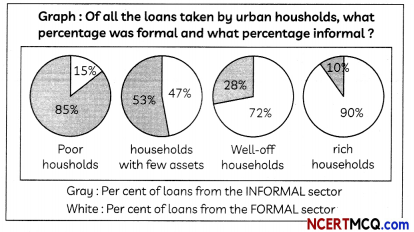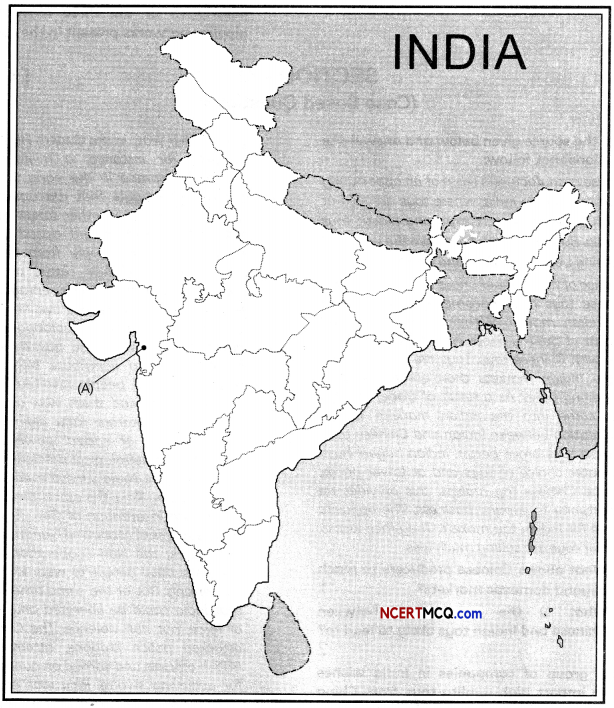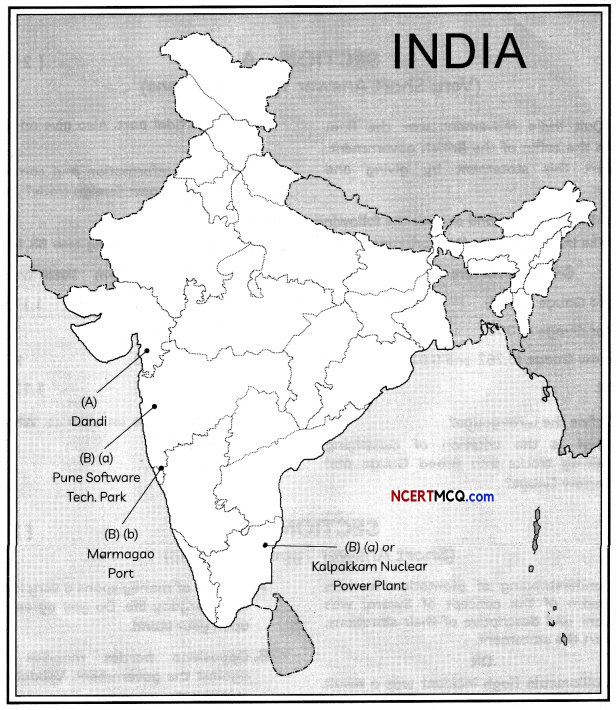Students can access the CBSE Sample Papers for Class 10 Social Science with Solutions and marking scheme Term 2 Set 1 will help students in understanding the difficulty level of the exam.
CBSE Sample Papers for Class 10 Social Science Term 2 Set 1 with Solutions
Time Allowed: 2 Hours
Maximum Marks: 40
General Instructions:
- This Question paper is divided into five sections-Section A, B, C, D and E.
- All questions are compulsory.
- Section-A: Question no. 1 to 5 are very short answer type questions of 2 marks each. Answer to each question should not exceed 40 words.
- Section-B: Question no. 6 to 8 are short answer type questions, carrying 3 marks each. Answer to each question should not exceed 80 words.
- Section-C: Question no. 9 and 10 are long answer type questions, carrying 5 marks each. Answer to each question should not exceed 120 words.
- Section-D: Question no. 11 and 12 are Case Based questions.
- Section-E: Question no. 13 is map based, carrying 3 marks with two parts, 13.1 from History (1 mark) and 13.2 from Geography (2 marks).
- There is no overall choice in the question paper. However, an internal choice has been provided in a few questions. Only one of the choices in such questions have to be attempted.
- In addition to this, separate instructions are given with each section and question, wherever necessary.
SECTION-A [2 × 5 = 10]
(Very Short Answer Type Questions)
Question 1.
How did Gandhi fight against the racist regime in South Africa? (2)
Answer:
Gandhi fought against the racist regime in South Africa with mass agitation using the method of Satyagraha,
Related Theory:
Thousar,ds of workers joined the satyagraha against racist laws that denied rights to non-whites in South Africa. This satyagraha was launched by Gandhi in the form of multiple movements.
Question 2.
Define the term Foreign investment. (2)
Answer:
Any investment made by foreign companies by either buying equity or bonds in native companies is called foreign investment.
Related Theory:
The money that is spent to buy assets such as land, building, machines and other equipment is called investment.
![]()
Question 3.
What can be done to put pressure on political parties? (2)
Answer:
Pressure can be put on political parties by citizens through processions, petitions and protests. These demonstrations prove extremely effcientt.
Related Theory:
Pressure can be put on political parties by people using multiple ways like processions, demonstrations, protests and petitions. People also form organizations like pressure groups, unions or interest groups to influence political parties indirectly.
Question 4.
Railways lndia bi”d the economic life of the country. Validate the statement. (2)
Answer:
Railways in India facilitate multifarious economic activities like agriculture, business, sightseeing, pilgrimage along with transportation of industrial goods over longer distances.
Related Theory
Railways give a boost to industrial and agricultural businesses by providing a transportation facility. They also help carry finished goods to the market.
Question 5.
Read the given data and answer the following questions.

(A) Why do rich households borrow mostly formal sector credit sources? (1)
Answer:
Rich households are more educated to finish the documentation-related formalities and have more facilities and properties to pledge as security. Poor households do not have these facilities.
(B) What are some of the sources of informal from credit? (1)
Answer:
Some sources of informal credit are:
- Mahajans
- Relatives
- Moneylenders
SECTION -B [3 × 3 = 9]
(Short Answer Type Questions)
Question 6.
Do you think democracy and economic development are interrelated? Validate your stand. (3)
Answer:
- Democracy and economic development have not followed each other in various cases. Economic development depends on factors like a country’s population size, global situation, production, size of economic activity, trade relations, cooperation from other countries, economic priorities adopted by the country, etc.
- Democracy can not ensure or guarantee of economic development.
Question 7.
The economic effects of the Non-cooperation movement were extremely prominent and dramatic. Enlist some of these effects.
OR
The Second Round Table Conference was a complete disappointment. Do you agree? Support your stand by giving a few reasons. (3)
Answer:
The economic effects of Non-cooperation movement were very dramatic.
- Foreign goods were boycotted, liquor shops picketed, and foreign cloth burnt in huge bonfires.
- The import of foreign cloth halved between 1921 and 1922.
- Merchants and traders refused to trade in foreign goods or finance foreign trade.
OR
The Second round table conference failed miserably. This was because-
- Gandhi hoped for more autonomy and self-governing institutions as a result from this conference.
- The negotiations broke down and Gandhi returned back disappointed.
- As a result, he relaunched the Civil diso-bedience movement upon coming back. The conference was thus a complete failure.
![]()
Question 8.
Why has Aluminium gained popularity as a substitute of steel, copper, zinc and lead in a number of industries? (3)
Answer:
Aluminium possesses the following qualities that make it popular as a substitute of steel, copper and zinc, etc.
- It is light and hence is used to manufacture aircraft and other equipment.
- It is resistant to corrosion. It is also a good conductor of heat.
- It becomes strong when it is mixed with other metals as an alloy. It thus helps to manufacture utensils and wires.
SECTION – C [5 × 2 = 10]
(Long Answer Type Questions)
Question 9.
Hindustan Socialist Republican Army was established not to promote a culture of gun and arms but to revolutionise society. Elaborate upon the given statement.
OR
What is defection? What steps have been mentioned in the Constitution of India to prevent defection? (5)
Answer:
The Hindustan Socialist Republican Army (HSRA) was founded at a meeting in Feroz Shah Kotla ground in Delhi in 1928 because:
- Some Nationalists believed that British couldn’t be overthrown by non-violence and Satyagraha alone.
- In the same pursuit, the HSRA targeted some of the symbols of British power.
- In April 1929, BhagatSingh and Batukeswar Dutta threw a bomb in the Legislative Assembly to create a fear among the British.
- The organisation was highly inspired by the socialist revolutionary ideas from the Russian revolution.
- Bhagat Singh stated that he did not wish to glorify ‘the cult of the bomb and pistol’ but wanted a revolution in society and hence he helped to form the HSRA.
OR
Defection is one of the most prevalent political ills in Indian politics. It directly harms the democratic nature of our election procedures. The Constitution of India was amended to include a new schedule with laws and rules against defection.
- The law says that those MLAs and MPs who change parties, will lose their seats in the legislature.
- Independent leaders will also lose their candidature if they were to join a political party during a given duration from their election.
- The new scheduLe also has multiple other laws to control the transfer of ministers from one party to another for the sake of money or authority. For example penalty.
Question 10.
The terms of credit vary substantially from one credit arrangement to another. They may vary depending on the nature of the lender and the borrower. What is credit? What are the terms of credit? Explain their meaning.
OR
What are pipeline? Give a detailed description of the three most important pipeline networks present in the country. (5)
Answer:
Credit is generally defined as an agreement in which a lender lends a particular amount or sum of money to a borrower in return of a guarantee to be paid back later.
The important terms of credit are defined as follows:
- Collateral: Collateral refers to an asset like a building or vehicle owned by the borrower, which is pledged as a security against which the loan is given to the borrower.
- Documentation: Before lending money, the lenders require proper papers of borrowers including the salary slip, income and employment records as a measure of security.
- Interest rate: While borrowing or lending money, both parties decide the rate of interest on which the amount is being lent.
- Duration of credit: Duration for which the credit is borrowed is another term of credit. It can vary according to the need of the borrower.
Related Theory
The borrower pays the principal amount added to the interest amount while repaying the loan.
OR
Piplelines are an alternative mode of transportation used for transporting crude oil, petroleum products and natural gas from oil and natural gas fields to refineries, fertilizer factories and big thermal power plants.
There are three important networks of pipeline transportation in the country:
- One pipeline runs from an oil field in upper Assam to Kanpur (Uttar Pradesh), via Guwahati, Barauni and Allahabad.
- Another pipeline runs through Salaya in Gujarat to Jalandhar in Punjab, via Viramgam, Mathura, Delhi and Sonipat. It has branches to connect Koyali in Gujarat to Chakshu.
- Another gas pipeline runs from Hazira in Gujarat to Jagdishpur in Uttar Pradesh, via Vijaipur in Madhya Pradesh.
These pipelines also have outlets and branches in different regions and cities in between the entry and end points.
SECTION-D [4 × 2 = 8]
(Case Based Questions)
Question 11.
Read the source given below and answer the questions that follow:
Chinese manufacturers Learn of an opportunity to export toys to India, where toys are sold at a high price. They start exporting pLastic toys to India. Buyers in India now have the option of choosing between Indian and Chinese toys. Because of the cheaper prices and new designs, Chinese toys have become more popular in the Indian market. Within a year, 70 to 80 percent of the toy shops have replaced Indian toys with Chinese toys. Toys are now cheaper in the Indian markets than earlier. What is happening here? As a result of trade, Chinese toys come into the Indian markets. In the competition between Indian and Chinese toys, Chinese toys prove better. Indian buyers have a greater choice of toys and at lower prices. For the Chinese toy makers, this provides an opportunity to expand business. The opposite is true for Indian toy makers. They face losses, as their toys are selling much less.
(A) What allows Chinese producers to reach beyond domestic markets? (1)
Answer:
Absence of any major trade barriers and easy trading processes because of better transportation and communication facilities allow Chinese producers of toys to reach beyond their domestic markets.
(B) What is the competition between Chinese and Indian toys likely to lead to? (2)
Answer:
The competition between Chinese and Indian toys is likely to lead to the following things:
- It might cause the Indian toy makers to strive for better technologies and cheaper raw materials.
- It is likely to cause destruction among the Indian toy industries. Multiple Indian toy makers are rendered out of business.
- Chinese toy makers are likely to buy Indian companies to increase their consumer base.
(C) A group of companies in India wishes to import high quality toys from China but have to pay a huge import tax on them leading to a decline in their sales. Ascertain the role of the import tax in this situation. (1)
Answer:
Here, the import tax led to a decline in the sales of toys imported from China. The import tax acted like a trade barrier here.
![]()
Question 12.
Read the source given below and answer the questions that follow:
Tribal peasants interpreted the message of Mahatma Gandhi and the idea of swaraj in yet another way. In the Gudem Hills of Andhra Pradesh, for instance, a militant guerrilla movement spread in the early 1920s – not a form of struggle that the Congress could approve. Here, as in other forest regions, the colonial government had closed large forest areas, preventing people from entering the forests to graze their cattle, or to collect fuelwood and fruits. This enraged the hill people. Not only were their livelihoods affected but they felt that their traditional rights were being denied.
When the government began forcing them to contribute begar for road building, the hill people revolted. The person who came to lead them was an interesting figure. Alluri Sitaram Raju claimed that he had a variety of special powers: he could make correct astrological predictions and heal people, and he could survive even bullet shots. Captivated by Raju, the rebels proclaimed that he was an incarnation of God. Raju talked of the greatness of Mahatma Gandhi, said he was inspired by the Non-Cooperation Movement, and persuaded people to wear khadi and give up drinking. But at the same time he asserted that India could be liberated only by the use of force, not non-violence. The Gudem rebels attacked police stations, attempted to kill British officials and carried on guerrilla warfare for achieving swaraj. Raju was captured and executed in 1924, and over time became a folk hero.
(A) Who was Alluri Sitaram Raju? (1)
Answer:
Alluri Sitarama Raju was a tribal leader who declared himself an incarnation of God and incited the local people against the British and organised them into a guerilla movement. He Led this movement and claimed he could heal people.
(B) How was Alluri Sitaram different from Mahatma Gandhi? (1)
Answer:
Alluri Sitaram was also a follower of Mahatma Gandhi and convinced people to give up drinking and boycott foreign goods. However, he was also different from Mahatma Gandhi because he believed that only violence could drive the British out of the country and the use of non-violence would not produce any results.
(C) How did the British government take away the rights of the tribal people? (2)
Answer:
The colonial government had dosed large forest areas, preventing people from entering the forests to graze their cattle, or to collect fuelwood and fruits. This enraged the hill people because they thought that this was an attack upon their traditions and their freedom.
Caution:
It is important for the students to be able to distinguish between different issues of different community/caste groups.
SECTION -E [1 × 3 = 3]
(Map Skill Based Questions)
Question 13.
(A) On the given outline Political Map of India, identify the place marked as A with the help of the following information and write its correct name on the line marked near it.
(a) Identify the place which is associated with the beginning of the Civil Disobedience Movement. (1)
(B) On the same given map of India, locate the following:
(a) Pune Software Technology Park
OR
Kalpakkam Nuclear Power Plant 1
(b) Marmagao Port 1

Answer:
(A) Dandi
OR
(B) (a) Pune Software Technology Park Kalpakkam Nuclear Power Plant
(b) Marmagao Port
